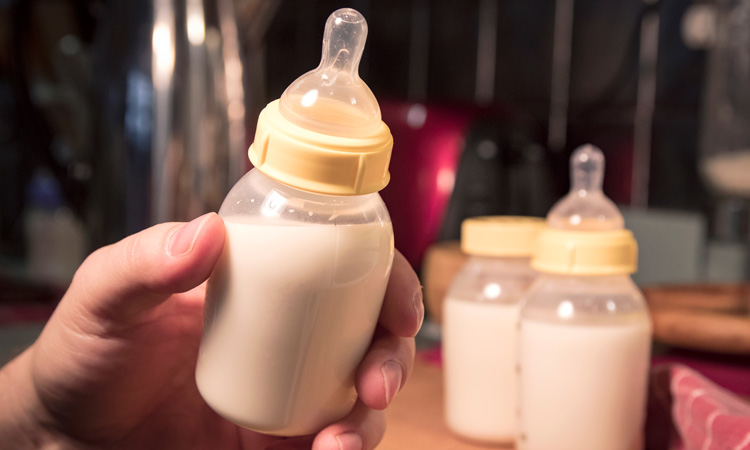Milk allergy guidelines may cause overdiagnosis in children, says research
- Like
- Digg
- Del
- Tumblr
- VKontakte
- Buffer
- Love This
- Odnoklassniki
- Meneame
- Blogger
- Amazon
- Yahoo Mail
- Gmail
- AOL
- Newsvine
- HackerNews
- Evernote
- MySpace
- Mail.ru
- Viadeo
- Line
- Comments
- Yummly
- SMS
- Viber
- Telegram
- Subscribe
- Skype
- Facebook Messenger
- Kakao
- LiveJournal
- Yammer
- Edgar
- Fintel
- Mix
- Instapaper
- Copy Link
Posted: 14 April 2020 | Sam Mehmet (New Food) | No comments yet
A team of researchers from Moscow and London found that although approximately 14 percent of parents believed their child to have a milk allergy, only one percent of them did in reality, which they said is due to official guidelines.


Current medical guidelines for diagnosing cow’s milk allergy in babies and young children may be linked to overdiagnosis of the condition, according to a new analysis from Imperial College London and Sechenov University in Moscow.
A team found that around one percent of children have a cow’s milk allergy, but up to 14 percent of families believe their child to have the condition. They pointed to official guidelines for detecting cow’s milk allergy as a possible cause for the overdiagnosis.
They analysed nine official guidelines for cow’s milk allergy which were published between 2012 and 2019 and were from a range of medical organisations in a number of countries, predominantly in Europe. The team found that many of the guidelines named symptoms such as excessive crying, regurgitating milk and loose stools as indications of cow’s milk allergy – but the authors argued that these symptoms are very common in normal, healthy babies.
The researchers also claimed that the prescription of specialist formulas for babies with cow’s milk allergy had increased significantly between 2000 and 2018 in countries such as Australia and England, without any evidence for an increase in cow’s milk allergy.
They then analysed the number of authors of the guidelines who had declared a conflict of interest with formula manufacturers, and found eight out of 10 of all guideline authors reported a conflict of interest. The team also found seven of the nine guidelines advised breast-feeding women to cut out all dairy from their diet if their child has a suspected cow’s milk allergy. However, their analysis of 13 studies of breastmilk composition suggested that less than one millionth of the protein from cow’s milk travels through to breast milk, and this would be too small to trigger a reaction in most allergic children.
Dr Robert Boyle, Consultant Allergy Specialist and lead author of the research from Imperial’s National Heart and Lung Institute, explained: “Many infants who are labelled as having milk allergy don’t have the condition. Having a child with suspected milk allergy can be a stressful time for any family. Misdiagnosing milk allergy could lead to another condition with similar symptoms being missed, or breast-feeding mothers needlessly following restricted diets – or even stopping breast-feeding altogether. It can also lead to families and the NHS unnecessarily paying for expensive specialist formula.”
“In the nine guidelines we studied, seven of them suggested including milder symptoms as indication of non-IgE cow’s milk allergy, such as regurgitating milk, crying and rashes – but many of these symptoms are present normally in babies, and will get better with time. Non-IgE cow’s milk allergy affects less than one percent of infants whereas troublesome vomiting, crying or eczema each affect 15-20 per cent of babies,” added Dr Daniel Munblit, Associate Professor of Paediatrics from Sechenov University and first author of the paper.
The team also found that three guidelines were directly supported by formula manufacturers or marketing consultants, and 81 percent of all guideline authors reported a conflict of interest with formula manufacturers. A conflict of interest means receiving funding from a company that could make a profit from the advice included in the guideline.
“Formula manufacturers may gain from promoting increased cow’s milk allergy diagnosis – by influencing practitioners and parents to use a specialised formula in place of a cheaper formula, and by potentially undermining women’s confidence in breastfeeding, so that specialised formula is used in place of breastmilk,” Dr Boyle said.
“We must not only critically appraise our current guidelines, and dissociate the development of guidelines from those who may profit from them, but also ensure we are giving each family the best possible care by avoiding overdiagnosis of cow’s milk allergy.”
Related topics
Allergens, Health & Nutrition, Regulation & Legislation, Research & development, The consumer








